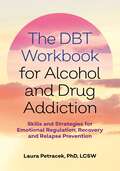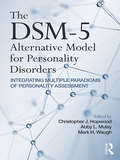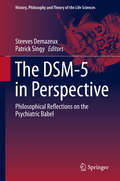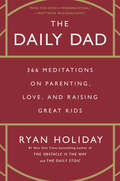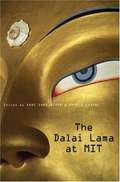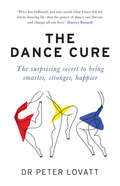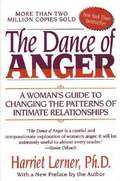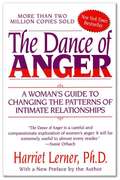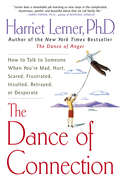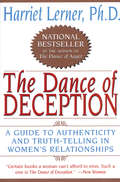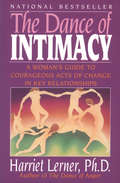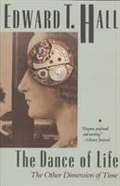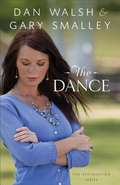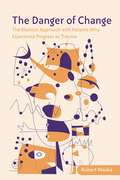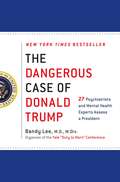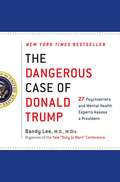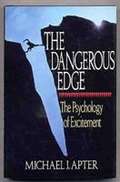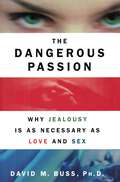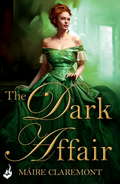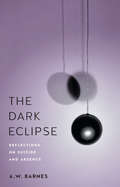- Table View
- List View
The DBT Workbook for Alcohol and Drug Addiction: Skills and Strategies for Emotional Regulation, Recovery, and Relapse Prevention
by Laura J. PetracekWhen recovering from addiction and managing a mental illness, it can feel like both have the ability to take over your life. By applying the principles of Dialectical Behaviour Therapy (DBT) to the 12 Steps addiction recovery approach, this workbook equips you with the tools to regulate your emotions, develop self-management skills, reduce anxiety and stress, and feel yourself again.DBT is a combination of CBT, mindfulness, and distress tolerance skills tailored to those who feel emotions very intensely. Exploring skills and strategies drawn from DBT that work in tandem with your recovery program, this book provides a new roadmap to reduce symptoms of emotional distress and to support your sobriety and mental health.Written by clinical psychologist, Laura Petracek, this ground-breaking workbook draws on the author's clinical and lived experience of addiction recovery, bipolar disorder, and other mental health challenges.
The DOSE Effect: Optimize Your Brain and Body by Boosting Your Dopamine, Oxytocin, Serotonin, and Endorphins
by Tj PowerA neuroscientist’s powerful framework for enhancing quality of life through the regulation of four key hormones: Dopamine, Oxytocin, Serotonin, and Endorphins (DOSE).The brain’s ability to change and adapt is one of the most powerful tools we can harness to improve our lives. Renowned neuroscientist and co-founder of Neurify, Tj Power, believes in the human ability to optimize and rewire brain chemistry to unlock one’s full potential. However, to do so, one must first implement a series of practical, life-changing strategies.The DOSE Effect reveals the secrets of our brain chemistry, offering simple and accessible ways to make modifications to your lifestyle that can transform your brain. Drawing on cutting-edge science, Power explores how biohacking your brain can not only enhance cognitive performance but also improve the aspects of your life that ultimately control a happier, healthier, and more productive lifestyle.The DOSE Effect proves the intrinsic connection between lifestyle factors and mental and physical well-being. Split into four sections, this essential guidebook provides the most effective techniques for understanding the key hormones that rule our thinking and our behaviors:Dopamine: your motivation and attention chemicalOxytocin: your relationships and confidence chemicalSerotonin: your mood and energy levels chemicalEndorphins: your stress reduction chemicalResearch-driven and deeply inspiring, Power’s revolutionary strategies allow readers to harness behaviors and practices to improve mental health, manage stress, elevate mood, and promote overall wellness. His key findings include the influence of effortful activity on Dopamine production, the significance of social connection in Oxytocin levels, the value of connecting with nature and maintaining gut health for optimal Serotonin levels, and the beneficial effects of physical exertion and laughter on Endorphins release. You have everything you need to optimize your brain chemistry—this groundbreaking book shows you how.
The DSM-5 Alternative Model for Personality Disorders: Integrating Multiple Paradigms of Personality Assessment
by Christopher J. Hopwood Abby L Mulay Mark H WaughThe DSM-5 Alternative Model for Personality Disorders reviews and advances this innovative and increasingly popular scheme for diagnosing and evaluating personality disorders. The authors identify the multiple clinical, theoretical, and research paradigms that co-exist in the Alternative Model for Personality Disorders (AMPD) and show how the model can aid the practicing mental health professional in evaluating and treating patients as well as its importance in stimulating research and theoretical understanding of this domain. This work explores and summarizes methods of personality assessment and psychiatric evaluation, research findings, and clinical applications of the AMPD, highlighting its usefulness to clinical teaching and supervision, forensic application, and current research. It is a go-to reference for experienced professionals and researchers, those who wish to learn this new diagnostic system, and for clinicians in training.
The DSM-5 in Perspective
by Steeves Demazeux Patrick SingySince its third edition in 1980, the Diagnostic and Statistical Manual of Mental Disorders (DSM) of the American Psychiatric Association has acquired a hegemonic role in the health care professions and has had a broad impact on the lay public. The publication in May 2013 of its fifth edition, the DSM-5, marked the latest milestone in the history of the DSM and of American psychiatry. In The DSM-5 in Perspective: Philosophical Reflections on the Psychiatric Babel, experts in the philosophy of psychiatry propose original essays that explore the main issues related to the DSM-5, such as the still weak validity and reliability of the classification, the scientific status of its revision process, the several cultural, gender and sexist biases that are apparent in the criteria, the comorbidity issue and the categorical vs. dimensional debate. For several decades the DSM has been nicknamed "The Psychiatric Bible. " This volume would like to suggest another biblical metaphor: the Tower of Babel. Altogether, the essays in this volume describe the DSM as an imperfect and unachievable monument - a monument that was originally built to celebrate the new unity of clinical psychiatric discourse, but that ended up creating, as a result of its hubris, ever more profound practical divisions and theoretical difficulties.
The Daily Dad: 366 Meditations on Parenting, Love, and Raising Great Kids
by Ryan Holiday&“Life is short. Do not forget about the most important things in our life, living for other people and doing good for them.&”—Marcus AureliusBecoming a parent is more than just a biological process – it&’s a lifelong commitment to sacrifice, service, and most importantly, love. It&’s a challenge to get up every day and put your kids first. You will experience moments of heroic compassion and humiliating failure, sometimes within the same day.But you don&’t have to do it alone. From Ryan Holiday, #1 New York Times bestselling author of the smash hit The Daily Stoic, The Daily Dad provides 366 timeless meditations on parenting in a few manageable paragraphs a day – useful for even the most sleep deprived new parent.Drawing on his own experience as a father of two as well as lessons from the lives of legends such as Theodore Roosevelt, Bruce Springsteen, Queen Elizabeth II, Marcus Aurelius, and Toni Morrison, this daily devotional provides wisdom and guidance on being the role model your child needs. Whether you&’re expecting your first or already a grandparent, The Daily Dad offers encouragement, perspective, and practical advice for every stage of your child&’s life.
The Dalai Lama at MIT
by Arthur Zajonc Anne HarringtonTheir meeting captured headlines; the waiting list for tickets was nearly 2000 names long. If you were unable to attend, this book will take you there. Including both the papers given at the conference, and the animated discussion and debate that followed, "The Dalai Lama at MIT" reveals scientists and monks reaching across a cultural divide, to share insights, studies, and enduring questions. Is there any substance to monks' claims that meditation can provide astonishing memories for words and images? Is there any neuroscientific evidence that meditation will help you pay attention, think better, control and even eliminate negative emotions? Are Buddhists right to make compassion a fundamental human emotion, and Western scientists wrong to have neglected it? "The Dalai Lama at MIT" shows scientists finding startling support for some Buddhist claims, Buddhists eager to participate in neuroscientific experiments, as well as misunderstandings and laughter. Those in white coats and those in orange robes agree that joining forces could bring new light to the study of human minds.
The Dalai Lama at MIT
by Anne Harrington and Arthur ZajoncTheir meeting captured headlines; the waiting list for tickets was nearly 2000 names long. If you were unable to attend, this book will take you there. Including both the papers given at the conference, and the animated discussion and debate that followed, The Dalai Lama at MIT reveals scientists and monks reaching across a cultural divide, to share insights, studies, and enduring questions. Is there any substance to monks’ claims that meditation can provide astonishing memories for words and images? Is there any neuroscientific evidence that meditation will help you pay attention, think better, control and even eliminate negative emotions? Are Buddhists right to make compassion a fundamental human emotion, and Western scientists wrong to have neglected it? The Dalai Lama at MIT shows scientists finding startling support for some Buddhist claims, Buddhists eager to participate in neuroscientific experiments, as well as misunderstandings and laughter. Those in white coats and those in orange robes agree that joining forces could bring new light to the study of human minds.
The Dance Cure: The surprising secret to being smarter, stronger, happier
by Peter Lovatt“Peter has brilliantly put into words what I have felt my whole dancing life: that the power of dance can liberate and change all our lives.” Darcey BussellHumans are born to dance. And in today’s sedentary world, we would all benefit from doing more of it. Science shows that just ten minutes of dancing provides a thorough work out for the body and brain, raising the heartbeat to cause a release of feel-good endorphins, connecting us to our emotions and reducing our stress levels. Dancing quite simply makes us feel more alive.Dr Peter Lovatt, a former professional dancer turned dance psychologist, has spent the past two decades studying why we dance and what it does for us, and is on a personal mission to make dancing as natural an activity in our daily lives as walking or drinking coffee.Filled with fascinating case studies from his research as well as great stories from dance history, The Dance Cure will inspire even those who think they “can’t dance” to turn the music on, get up on the floor and dance themselves happy.
The Dance of Anger: A Woman's Guide to Changing the Patterns of Intimate Relationships
by Harriet G. LernerAnger is one of the most painful emotions we experience, and the most difficult to use wisely and well. Yet our anger is an important signal that always deserves our attention and respect. The difficulty is that feeling angry doesn't tell us what is wrong, or what specifically we can do that will make things better rather than worse. That's why I wrote The Dance of Anger -to help readers not only to identify the true sources of their anger, but also to learn how to change the patterns from which anger springs. The challenge of anger is at the heart of our struggle to achieve intimacy, self-esteem, and joy. Learning how to deal with it is worth the journey, even though there are no six-easy-steps to personal fulfillment and relational bliss. The Dance of Anger teaches readers to understand how relationships operate and how to change our part in them. It encourages readers to go the hard route.
The Dance of Anger: A Woman's Guide to Changing the Patterns of Intimate Relationships
by Harriet Lerner"Anger is a signal and one worth listening to," writes Dr. Harriet Lerner, in her renowned classic that has transformed the lives of millions of readers. While anger deserves our attention and respect, women still learn to silence our anger, to deny it entirely, or to vent it in a way that leaves us feeling helpless and powerless. In this engaging and eminently wise book, Dr. Lerner teaches women to identify the true sources of our anger and to use anger as a powerful vehicle for creating lasting change.
The Dance of Connection
by Harriet LernerIn her most affirming and life-changing book yet, Dr. Harriet Lerner teaches us how to restore love and connection with the people who matter the most. In The Dance of Connection we learn what to say (and not say) when: We need an apology, and the person who has harmed us won't apologize or be accountable. We don't know how to take a conversation to the next level when we feel desperate. We feel worn down by the other person's criticism, negativity, or irresponsible behavior. We have been rejected or cut off, and the other person won't show up for the conversation. We are struggling with staying or leaving, and we don't know our "bottom line." We are convinced that we've tried everything -- and nothing changes.Filled with compelling personal stories and case examples, Lerner outlines bold new "voice lessons" that show us how to speak with honor and personal integrity, even when the other person behaves badly. Whether we're dealing with a partner, parent, sister, or best friend, The Dance of Connection teaches us how to navigate our most important relationships with clarity, courage, and joyous conviction.
The Dance of Deception: Pretending and Truth-Telling in Women's
by Harriet LernerWhen The Dance of Deceptionwas published, Lerner discovered that women were not eager to identify with the subject. "Well, I don't do deception" was a common resonse.We all "do deception", often with the intention to protect ourselves and the relationships we depend on. The Dance of Deceptionunravels the ways (and whys) that women show the false and hide the real -- even to our own selves. We see how relationships are affected by lying and faking, by silence and pretending and by brave -- but misguided -- efforts to tell the truth.Truth-telling is at the heart of what is most central in women's lives. It is at the foundation of authenticity and creativity, intimacy and joy. Yet in the name of "honesty", we can bludgeon each other. We can approach a difficult issue with such a poor sense of timing and tact that we can actually shut down the lines of communication rather than widening the path of truth-telling.Sometimes Lerner's advice takes a surprising turn -- for example, when she asks us to engage in a bold act of pretending in order to discover something "more real"; or when she tells us not to parachute down on our family to bring up a "hot issue" without laying the necessary groundwork first.Whether the subject is affairs, family secrets, sexual faking or the challenge of "being oneself", Lerner helps us to discover, speak and live our own truths.
The Dance of Deception: Pretending and Truth-Telling in Women's Lives
by Harriet G. LernerDrawing on more than two decades of clinical experience, Dr. Lerner articulates her rich philosophy and thoughtful guidelines about speaking out, from sexual faking to family secrets.
The Dance of Interaction
by Jeanine FitzgeraldSuggests creative solutions for handling challenging behaviors of children.
The Dance of Intimacy
by Harriet G. LernerA wise and compassionate book that will teach the reader much about the complex emotions our family and love relationships engender.
The Dance of Intimacy: A Woman's Guide to Courageous Acts of Change in Key Relationships
by Harriet LernerIn The Dance of Intimacy, the bestselling author of The Dance of Anger outlines the steps to take so that good relationships can be strengthened and difficult ones can be healed. Taking a careful look at those relationships where intimacy is most challenged--by distance, intensity, or pain--she teaches us about the specific changes we can make to achieve a more solid sense of self and a more intimate connectedness with others. Combining clear advice with vivid case examples, Dr. Lerner offers us the most solid, helpful book on intimate relationships that both women and men may ever encounter.
The Dance of Life: The Other Dimension of Time
by Edward T. Hall<p>In his pioneering work The Hidden Dimension, Edward T. Hall spoke of different cultures' concepts of space. Now The Dance of Life reveals the ways in which individuals in culture are tied together by invisible threads of rhythm and yet isolated from each other by hidden walls of time. Hall shows how time is an organizer of activities, a synthesizer and integrator, and a special langauge that reveals how we really feel about each other. <p>Time plays a central role in the diversity of cultures such as the American and the Japanese, which Hall shows to be mirror images of each other. He also deals with how time influences relations among Western Europeans, Latin Americans, Anglo-Americans, and Native Americans.</p>
The Dance: A Novel (Book 1 in the Restoration Series)
by Gary Smalley Dan WalshJim Anderson is a successful businessman, and his wife, Marilyn, is the perfect wife. And why wouldn't she be? He gives her everything she needs. That's why Jim never expected to come home one day and find Marilyn gone. After 27 years of marriage, Marilyn has had enough of feeling unloved and neglected. She wants to experience some measure of happiness before she's too old to enjoy it, even signing up for dance lessons, something Jim would never do. What will it take for Jim to finally become the man Marilyn needs him to be? Combining the literary talents of bestselling author Dan Walsh and the relationship expertise of bestselling author Gary Smalley, The Dance is the first novel in The Restoration Series. Readers will get caught up in these flawed but sincere members of the Anderson family as they rediscover genuine love and start a transformation that ultimately affects all of them.
The Danger of Change: The Kleinian Approach with Patients Who Experience Progress as Trauma
by Robert WaskaConfusing clinical standoffs, loyalty to self-destruction and abrupt terminations are challenging and under-examined problems for the modern psychoanalytic practitioner. The Danger of Change is a timely book that addresses the so-called resistant patient so many clinicians are familiar with. Robert Waska blends theory based on Melanie Klein’s classical stance with the more contemporary Freudian/Kleinian school, to demonstrate how to understand patients that are resistant to progress. Divided into four sections, this book covers: reluctant patients and the fight against change: caught between the paranoid and depressive world greed and the dangers of change interruptions to the process of change: loss, envy, and the death instinct working toward change in the face of overwhelming odds Extensive and detailed clinical material is used to bring clarity to subjects including symbolism, conflict resolution, projective identification, the depressive and paranoid positions, change and trust. The Danger of Change brings hope and clarity to cases involving patients who experience progress as a threat to their emotional wellbeing. It will be of great interest to all practising psychoanalysts, as well as those studying psychoanalytic theory and practice.
The Dangerous Case of Donald Trump: 27 Psychiatrists and Mental Health Experts Assess a President
by Gail Sheehy Noam Chomsky Tony Schwartz Judith Lewis Herman James Gilligan Philip Zimbardo Nanette Gartrell John D. Gartner Edwin B. Fisher Robert Jay Lifton William J. Doherty Esq. Lance Dodes M. P. H. Rosemary Sword Bandy X. Lee Craig Malkin Michael J. Tansey David M. Reiss Henry J. Friedman Jennifer Contarino Panning Psy.D. Luba Kessler Steve Wruble Thomas Singer Dee Mosbacher Leonard L. Glass Howard H. Covitz James A. Herb M.A. Diane Jhueck L.M.H.C. D.M.H.P. A.B.P.P. Betty P. Teng M.F.A. L.M.S.W. Harper West M.A. L. L. P. Elizabeth Mika M.A. L.C.P.C.<P>More than two dozen psychiatrists and psychologists offer their consensus view that Trump's mental state presents a clear and present danger to our nation and individual well-being.This is not normal.Since the start of Donald Trump’s presidential run, one question has quietly but urgently permeated the observations of concerned citizens: What is wrong with him? <P>Constrained by the American Psychiatric Association’s “Goldwater rule,” which inhibits mental health professionals from diagnosing public figures they have not personally examined, many of those qualified to answer this question have shied away from discussing the issue at all. The public has thus been left to wonder whether he is mad, bad, or both. <P>In THE DANGEROUS CASE OF DONALD TRUMP, twenty-seven psychiatrists, psychologists, and other mental health experts argue that, in Mr. Trump’s case, their moral and civic “duty to warn” America supersedes professional neutrality. They then explore Trump’s symptoms and potentially relevant diagnoses to find a complex, if also dangerously mad, man.Philip Zimbardo and Rosemary Sword, for instance, explain Trump’s impulsivity in terms of “unbridled and extreme present hedonism.” Craig Malkin writes on pathological narcissism and politics as a lethal mix. Gail Sheehy, on a lack of trust that exceeds paranoia. Lance Dodes, on sociopathy. Robert Jay Lifton, on the “malignant normality” that can set in everyday life if psychiatrists do not speak up. <P>His madness is catching, too. From the trauma people have experienced under the Trump administration to the cult-like characteristics of his followers, he has created unprecedented mental health consequences across our nation and beyond.It’s not all in our heads. It’s in his. <P><b>A New York Times Bestseller</b>
The Dangerous Case of Donald Trump: Based on the Yale Conference, Two Dozen Mental Health Experts Assess a President
by Bandy X. LeeThe New York Times bestseller! More than two dozen psychiatrists and psychologists offer their consensus view that Trump's mental state presents a clear and present danger to our nation and individual well-being. This is not normal. Since the start of Donald Trump's presidential run, one question has quietly but urgently permeated the observations of concerned citizens: What is wrong with him? Constrained by the American Psychiatric Association's "Goldwater rule," which inhibits mental health professionals from diagnosing public figures they have not personally examined, many of those qualified to answer this question have shied away from discussing the issue at all. The public has thus been left to wonder whether he is mad, bad, or both. In THE DANGEROUS CASE OF DONALD TRUMP, twenty-seven psychiatrists, psychologists, and other mental health experts argue that, in Mr. Trump's case, their moral and civic "duty to warn" America supersedes professional neutrality. They then explore Trump's symptoms and potentially relevant diagnoses to find a complex, if also dangerously mad, man. Philip Zimbardo and Rosemary Sword, for instance, explain Trump's impulsivity in terms of "unbridled and extreme present hedonism. " Craig Malkin writes on pathological narcissism and politics as a lethal mix. Gail Sheehy, on a lack of trust that exceeds paranoia. Lance Dodes, on sociopathy. Robert Jay Lifton, on the "malignant normality" that can set in everyday life if psychiatrists do not speak up. His madness is catching, too. From the trauma people have experienced under the Trump administration to the cult-like characteristics of his followers, he has created unprecedented mental health consequences across our nation and beyond. It's not all in our heads. It's in his. "There will not be a book published this fall more urgent, important, or controversial than The Dangerous Case of Donald Trump. . . profound, illuminating and discomforting" --Bill Moyers
The Dangerous Edge: The Psychology of Excitement
by Michael J. Aptera GREAT book on people's attraction to danger
The Dangerous Passion: Why Jealousy Is as Necessary as Love and Sex
by David M. BussWhy do men and women cheat on each other? How do men really feel when their partners have sex with other men? What worries women more -- men who turn to other women for love or men who simply want sexual variety in their lives? Can the jealousy husbands and wives experience over real or imagined infidelities be cured? Should it be? In this surprising and engaging exploration of men's and women's darker passions, David Buss, acclaimed author of The Evolution of Desire, reveals that both men and women are actually designed for jealousy. Drawing on experiments, surveys, and interviews conducted in thirty-seven countries on six continents, as well as insights from recent discoveries in biology, anthropology, and psychology, Buss discovers that the evolutionary origins of our sexual desires still shape our passions today. According to Buss, more men than women want to have sex with multiple partners. Furthermore, women who cheat on their husbands do so when they are most likely to conceive, but have sex with their spouses when they are least likely to conceive. These findings show that evolutionary tendencies to acquire better genes through different partners still lurk beneath modern sexual behavior. To counteract these desires to stray -- and to strengthen the bonds between partners -- jealousy evolved as an early detection system of infidelity in the ancient and mysterious ritual of mating. Buss takes us on a fascinating journey through many cultures, from pre-historic to the present, to show the profound evolutionary effect jealousy has had on all of us. Only with a healthy balance of jealousy and trust can we be certain of a mate's commitment, devotion, and true love.
The Dark Affair: Mad Passions Book 3 (Mad Passions)
by Maire ClaremontA richly romantic and enthralling novel of beauty, passion and scandalous secrets from Maire Claremont, the acclaimed author of The Dark Lady and Lady In Red. Perfect for fans of Sherry Thomas, Johanna Lindsey and Lisa Kleypas.Lady Margaret Cassidy left a life of nobility behind in Ireland, forsaking her grieving homeland to aid war-ravaged men in England. Still, she never expected a cruel turn of fate to lock her into an unwanted betrothal with one of her English patients - much less one as broken and dangerous as Viscount Powers.Wrecked by his tragic past, Powers' opiate-addled sanity hangs precariously in the balance, leaving him poised to destroy anyone who dares to utter the names of the wife and child he still so deeply mourns. So when he is forced to marry Margaret in exchange for freedom, he is shocked by the desire to earn her trust, her body, and - most alarming of all - her heart...For more deliciously dark Victorian romance, try all the titles in the Mad Passions series: The Dark Lady, Lady In Red, A Lady Undone and The Dark Affair, and check out Maire's alter-ego Eva Devon for sexy and laugh-out-loud funny Regencies.
The Dark Eclipse: Reflections on Suicide and Absence
by A. W. BarnesThe Dark Eclipse is a book of personal essays in which author A.W. Barnes seeks to come to terms with the suicide of his older brother, Mike. Using source documentation—police report, autopsy, suicide note, and death certificate—the essays explore Barnes’ relationship with Mike and their status as gay brothers raised in a large conservative family in the Midwest. In addition, the narrative traces the brothers’ difficult relationship with their father, a man who once studied to be a Trappist monk before marrying and fathering eight children. Because of their shared sexual orientation, Andrew hoped he and Mike would be close, but their relationship was as fraught as the author’s relationship with his other brothers and father. While the rest of the family seems to have forgotten about Mike, who died in 1993, Barnes has not been able to let him go. This book is his attempt to do so. Published by Bucknell University Press. Distributed worldwide by Rutgers University Press.
